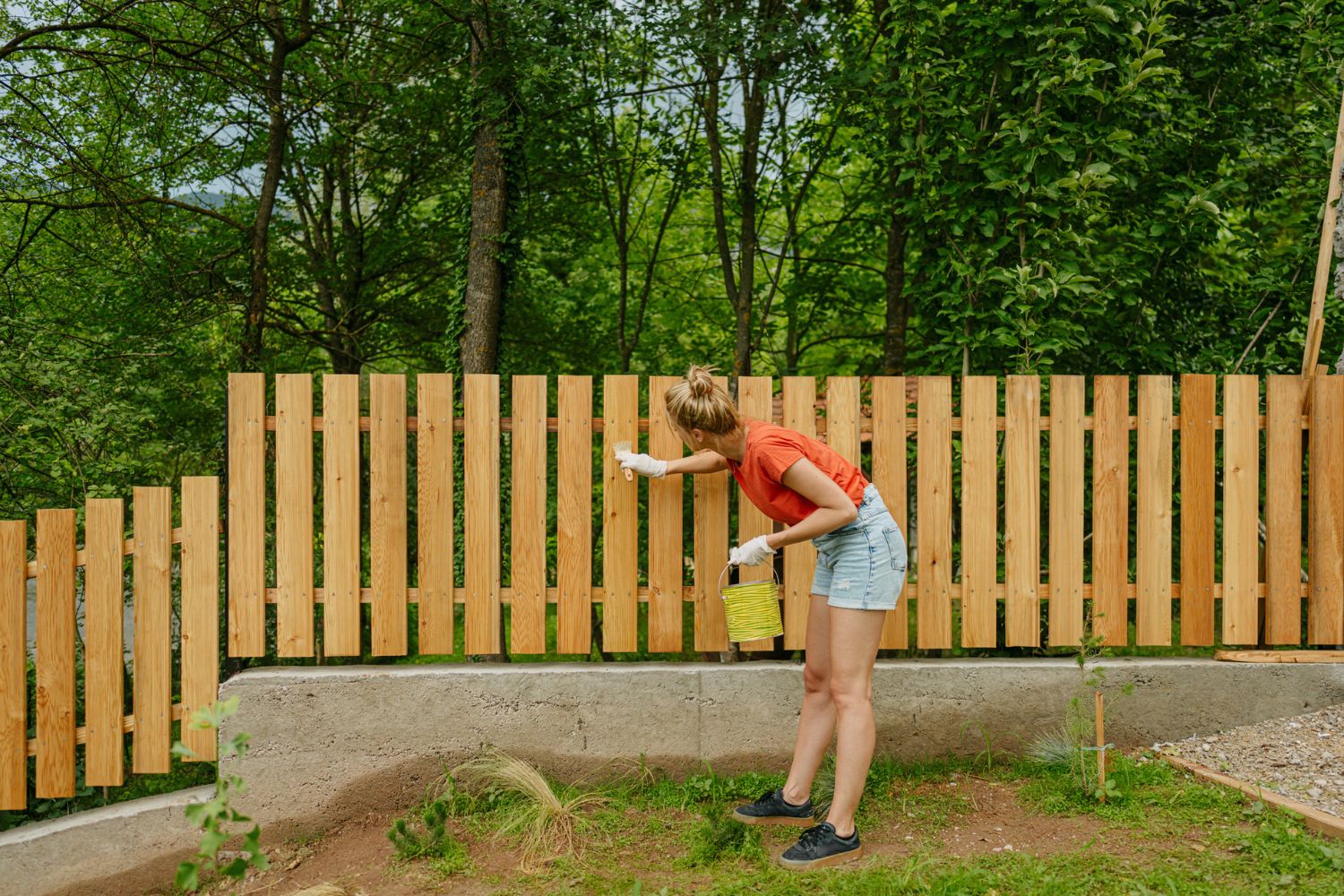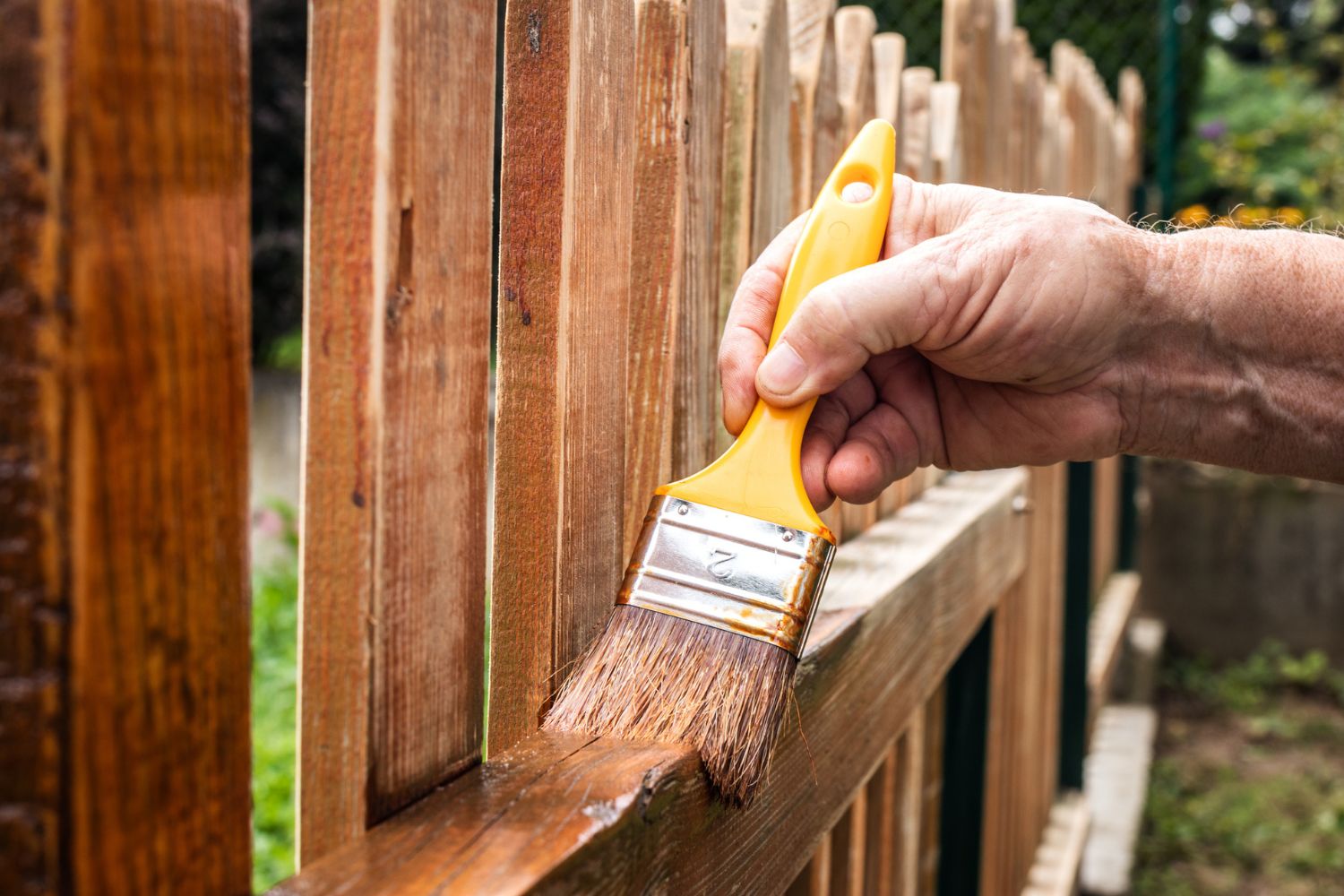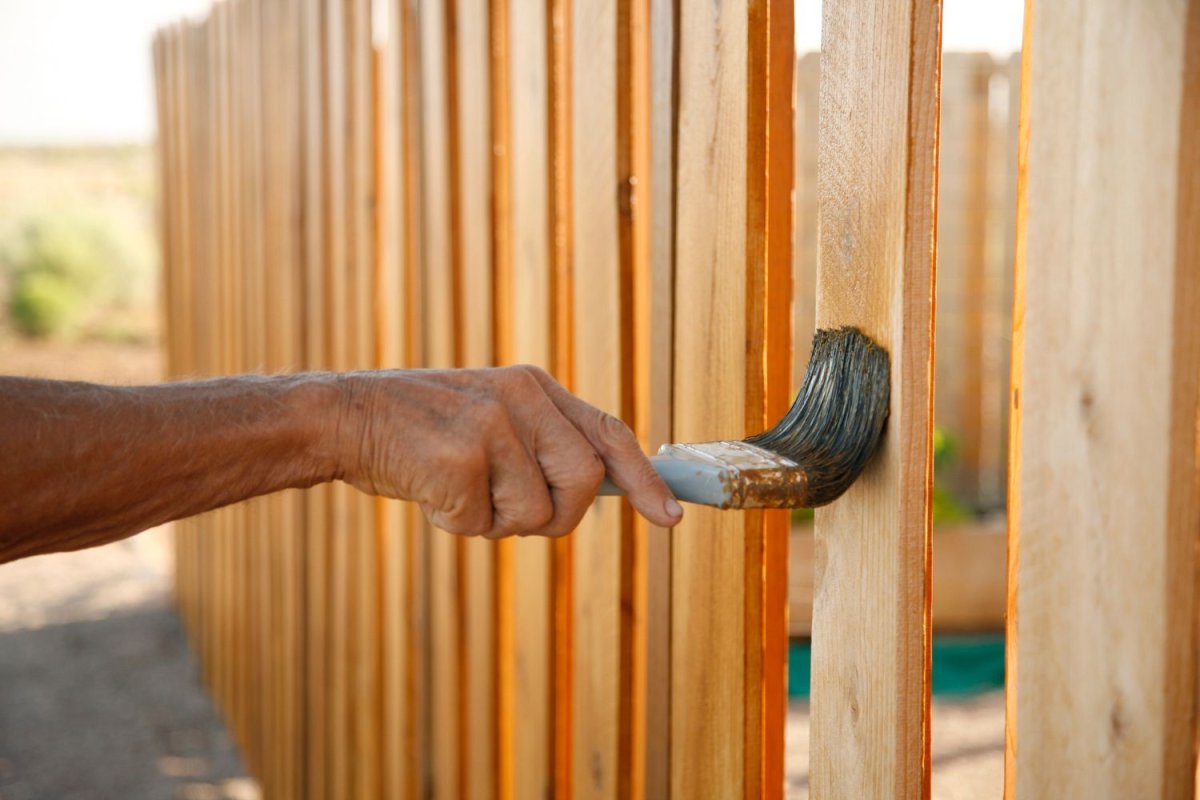We may earn revenue from the products available on this page and participate in affiliate programs. Learn More ›
Highlights
- The typical cost to paint a fence ranges from $750 to $4,250, with a national average cost of $1,700.
- The exact cost for fence painting will depend on the fence height, length, type, and material; the paint type and finish; the primer type; the cost of labor; and the home’s geographic location.
- Painting a fence can help provide weather protection as well as increase the lifespan of the fence, improve its aesthetics, and raise the property value.
- A homeowner may be able to tackle a small fence painting project on their own. However, because this is a labor-intensive project, many homeowners prefer to leave the work to a professional fence painting company.
Peeling paint or a faded stain on a fence might not affect how well it keeps nosy neighbors out of the yard, but it can reduce the property’s value. A dilapidated fence is unsightly and can be a precursor to further weather damage to the fence. Fortunately, a fresh coat of paint or stain can revitalize just about any fence.
According to Angi and HomeAdvisor, the average fence painting cost is $1,700, but a typical range is $750 to $4,250. The wide price range correlates to the length, height, and type of fence that needs painting, since a 4-foot-tall fence in the front yard has much less area to paint than an 8-foot-tall fence around an entire property. Fence painters charge by the hour or by the linear foot, but the cost will include labor and materials unless otherwise specified. Homeowners who learn about what makes up the average cost to stain a fence will be well prepared to vet a professional fence painting company.

Key Cost Factors
Staining or painting a fence can be an easy or complicated task, depending on the size of the fence, the type of material, and the current condition. The type of paint or stain and primer can also affect the cost since more than one coat is typically applied. All of these factors will play into the cost to stain a fence, along with local labor rates.
Fence Height and Length
Many homes have a tall privacy fence that surrounds the backyard and connects to the house and garage. Others have a fence that extends around the front yard as well, though this is usually a shorter fence than the backyard fence. Ultimately, the height and total linear feet of the fence line will greatly impact the fence painting cost. More surface area means more materials and labor to complete the job, so an 8-foot-tall fence will cost much more to paint or stain than a 4-foot-tall fence.
Two coats of paint are often necessary to help protect against weathering. On average, fence painting will cost $3 to $14 per linear foot, but this range usually applies to a single coat of primer and paint. Taller-than-average fences may also have a higher cost per linear foot.
|
Fence Length |
Average Cost (Materials and Labor) |
|
50 linear feet |
$150 to $700 |
|
75 linear feet |
$225 to $1,050 |
|
100 linear feet |
$300 to $1,400 |
|
150 linear feet |
$450 to $2,100 |
|
200 linear feet |
$600 to $2,800 |
|
300 linear feet |
$900 to $4,200 |
|
400 linear feet |
$1,200 to $5,600 |
Fence Type and Material
Fences come in all shapes, sizes, and materials. Each also comes with its own price point for installation and painting or staining. For example, a standard picket fence will likely cost less to paint than a wrought-iron fence for two reasons: picket fences are often shorter than wrought-iron fences, and they don’t need an additional coat of rust-proof primer.
Some homeowners prefer a vinyl fence, a metal and aluminum fence, or a shadowbox fence, where the pickets alternate on either side of the rail. Common types of wooden fences also include privacy, lattice, split-rail, and post-and-rail.
|
Type of Wooden Fence |
Average Cost (Materials and Labor) |
|
Lattice |
$4 to $7 per linear foot |
|
Picket |
$2.75 to $4 per linear foot |
|
Post-and-rail |
$2.25 to $3.50 per linear foot |
|
Privacy |
$4 to $12 per linear foot |
|
Split rail |
$2.25 to $3.50 per linear foot |
Paint Type and Finish
Homeowners have several options when it comes to the final appearance of their new or revitalized fence. Fences of all types can be painted a variety of colors if a pop of color is desired, while wooden fences can also be stained to enhance a certain natural hue. Many stains also have different finishes, so homeowners will need to choose a transparent, semi-transparent, or solid finish depending on the look they’re going for.
Some certain types of paints and stains will adhere better to fencing material, so homeowners are advised to speak with a fence painting specialist who can recommend the best fence paint or best fence stain. It should be rated for outdoor use to resist UV penetration and water damage; otherwise, a jet-black fence can fade to a navy blue unexpectedly. Acrylic, latex, and oil-based paints are the most common options, though the ideal choice will depend on the fence material.
The cost per gallon for outdoor fence paint averages $20 to $80, while stain averages $20 to $50. More than one coat of primer and paint might need to be applied, depending on the condition of the fence.
Primer Type
Fence painting companies will know what kind of primer is best for a fence. A wooden fence will need a standard primer, but a vinyl fence will require a special type of primer to ensure a strong bond between the vinyl and paint. And a metal or wrought-iron fence should have a rust-resistant primer applied to the surface to protect against weathering. Sometimes more than one coat of primer is needed, which will increase the cost, due to the extra time, labor, and materials needed. Primers typically cost between $20 and $50 per gallon.
Labor
The labor cost to stain a fence makes up more than half of the price. Usually, the hourly rate for fence painting can run between $25 and $100, but most fence painters will charge by the linear foot. Either way, labor is a significant part of the cost since it’s a labor-intensive job to prep, prime, and paint the fence. It’s also worth noting that many fence painting services charge a minimum rate to cover their time and expenses. This minimum rate is often $250 to $500, which means it’s likely worth it for homeowners to do smaller painting jobs on their own or check with a local handyman.
Geographic Location
The cost to paint a fence also depends on the geographic location of the property. Urban areas with higher costs of living tend to have higher labor and material costs than more rural areas. However, the current demand for fence painting can also influence the cost in any location.

Additional Costs and Considerations
Aside from the primary cost factors for fence painting, some homeowners may need to evaluate other situations or conditions that could apply to their fence. The choice between paint and stain, the need for preparation work or additional coats of paint, and necessary fence repairs are all considerations that have an impact on the final price.
Paint vs. Stain
There is a difference in cost between fence staining and fence painting. For starters, a gallon of paint can cost up to $80, while a gallon of stain typically caps at $50. Second, most exterior stains don’t require the use of a primer since they tend to self prime. This reduces the time and material cost of applying a coat of primer.
However, since paint is applied over a primer, a gallon of paint tends to go further than a gallon of stain that’s immediately absorbed by the wood. On average, a gallon of stain can be applied to 27 linear feet, while a gallon of paint is often enough for 33 linear feet. That means more gallons of stain will be required for a long fence, but again, no primer is needed.
Preparation Work
Unless the fence is brand-new, homeowners can expect to pay for preparation work to get the fence ready for primer and paint. This could include pressure washing ($150 to $300), sanding or sandblasting ($2 to $8 per square foot), or scraping the paint. A metal fence will likely require manual scraping with a wire brush to remove the paint fully before applying the rust-proof primer. A fence that has previously been stained will require less prep work than a painted wooden or metal fence since stain typically fades rather than peels or chips.
It’s also possible that landscaping will need to be removed or trimmed to ensure the painters can fully access the fence. Prep work could be charged by an hourly rate or by linear foot, so homeowners are encouraged to ask how this project is calculated.
Additional Coats of Paint
Since a fence is constantly subjected to UV rays, wind, debris, and water, a second coat of paint is usually recommended to extend the longevity of the fence painting job. This will increase the total price since the painter will work on double the amount of fence. So a 100-foot fence with one coat of primer and two coats of paint would be estimated as a 300-foot fence. If the homeowner opts to have their wooden fence stained, then a 100-foot fence would need only one or two coats of stain.
Fence Repairs
In some cases, a fence that has sat in disrepair for years will need more than a little prep work and fresh paint to get it shipshape again. Sagging, leaning, cracks, and broken panels or gates are all signs that the fence needs some additional repairs. Nail holes will need to be filled, and rotten or missing boards will need to be replaced. Fortunately, fence repair costs between $302 and $922, which is cheaper than the cost to install a new fence at $1,743 to $4,431. Homeowners can ask one of the best fence companies about local repair and repainting costs.
Cost by Fence Type
The cost of painting a fence will vary depending on the type of fence on the property. The most common types of fences are metal or aluminum, shadowbox, vinyl, wood picket, wood privacy, or wrought-iron. These are a mix of styles and materials, and they come with their own average cost per linear foot.
|
Type of Fence |
Average Cost (Materials and Labor) |
|
Metal or aluminum |
$4 to $10 per linear foot |
|
Shadowbox |
$4 to $14 per linear foot |
|
Vinyl |
$3.75 to $10 per linear foot |
|
Wood picket |
$2 to $5 per linear foot |
|
Wood privacy |
$2 to $10 per linear foot |
|
Wrought iron |
$5 to $12 per linear foot |
Metal or Aluminum
A chain-link aluminum fence is a common, low-cost fence to install if the homeowner is mostly concerned about keeping kids and pets in the yard. But some aluminum fences can also look like a picket or shadowbox fence for a trendier appearance. Aluminum fences cost around $4,149 to install and $4 to $10 per linear foot to paint.
Metal fences are more costly to install and paint, so homeowners can expect to pay the higher price range. A rust-proof primer is necessary to ensure the longevity of a metal fence, unless it’s a metal that’s naturally rust-resistant, like aluminum.
Shadowbox
A shadowbox fence is a unique fence style that offers more privacy than a chain-link fence but not as much as a full privacy fence. The vertical pickets are placed on alternating sides of the horizontal rails, adding depth and charm to the fence. It costs $4 to $14 per linear foot to paint or stain a shadowbox fence since it’s more difficult to access each picket during the preparation and painting processes.
Vinyl
Many homeowners choose to install vinyl fences due to their easy maintenance and longevity. Though most vinyl fences come in traditional white, other colors are available, and some homeowners prefer to do a composite mixed with sawdust to give the appearance of wood. It’s not common to paint or stain a vinyl fence, but if some panels need a refresh, then an adhesive primer and epoxy-based paint are necessary to ensure proper adhesion. Vinyl fence painting costs $3.75 to $10 per linear foot.
Wood Picket Fence
A picket fence typically costs less to paint than a privacy fence. The reason is the shorter size: 48 inches or less. With less surface area to paint, picket fences will take less time and require fewer materials to get the job done. Painting a picket fence costs about $2 to $5 per linear foot, while installation costs $10 to $75 per linear foot. This is a much higher cost range than a split-rail fence cost, which averages $10 to $30 per linear foot.
Wood Privacy Fence
Wooden fence painting has a wide price range since it depends on the fence size and number of paint or stain coats required. Privacy fences are usually at least 6 feet high, but some could be 8 feet high or more, especially if they’re located on a slope. It could cost between $2 and $10 per linear foot to paint or stain a wooden privacy fence. A privacy fence installation cost averages $10 to $50 per linear foot.
Wrought-Iron
In terms of installation, the average wrought-iron fence cost is about the same as a wood fence cost: just over $3,000. But the cost to paint a wrought-iron fence trends higher due to the extra preparation needed and additional rust-resistant primer required. Most homeowners will spend $5 to $12 per linear foot to strip and repaint a wrought-iron fence professionally.

Benefits of Fence Painting
Homeowners who choose to paint their fence enjoy a variety of benefits, no matter if it’s a new or old fence. Some of these benefits include better protection from weather, an increased lifespan, and improved aesthetics—all of which contribute to an increased property value.
Weather Protection
Wooden fences are prone to weathering more than other types of fences since wood will naturally begin to rot due to moisture exposure. But any type of fencing material will experience deterioration from sun and water exposure, which is why painting or staining on a regular basis are suggested. Fence staining companies can recommend the ideal stain or paint for a wooden fence or the ideal primer and paint for a metal fence. The right combination of materials will ensure the fence is protected against UV rays and moisture damage for several years.
Increased Lifespan
Though it’s recommended to let a new wooden fence dry for 1 to 6 months before staining it, the application of stain or paint is well known to extend the life of a fence. Stains can prevent moisture from soaking into the wood, though reapplication is needed after about 3 years on average. The combination of primer and a quality paint protects metal, wood, and aluminum from weathering so they last longer than average. Homeowners who paint a fence will usually need to repaint after 5 to 10 years.
Improved Aesthetics
Peeling, cracking, chipping, and faded paint are unappealing to look at. And in many cases, a poor paint surface is accompanied by a fence that needs repairs. Many homeowners opt to repair and paint a fence at the same time if the fence needs extra attention. A fence that looks as if it’s been taken care of helps add curb appeal to the home and even the neighborhood.
Customization Options
Homeowners with a bigger budget may prefer to add some customizations or design features to their fence. For instance, they may want to paint the fence a different color to match or contrast with the color of the house. And adding a driveway gate can be appealing as a visual feature or security element. If a new gate or fence panels are needed, then it’s likely that the entire fence may need to be painted or stained to match the color of the new feature.
Increased Property Value
Any home or property that has obvious signs of disrepair or neglect will have a lower property value. The best way to maintain or increase property value is to keep each part of the home or property in good condition. Repairing a driveway, laying sod, repairing gutters, and staining or painting a fence are just a few ways that homeowners can keep up their property value.
DIY vs. Hiring a Professional
Since most fence staining costs are made up of labor, many homeowners consider painting their fencing on their own to keep costs down. If the homeowner has the time and physical ability to paint their fence, then it’s certainly possible to do so. This is especially true if there’s only a small section of the fence that needs new stain or paint. Since a fence painting company will often charge a minimum fee for painting, homeowners can often save quite a bit of money by repainting the small section on their own.
However, one area where a DIYer often underestimates the time and effort involved is the preparation work. It takes considerable work to clean and remove all traces of old paint from any fence but especially a metal fence. This tedious work can significantly increase the length of time of the project. There’s also a consideration of the type of paint or stain to use. Homeowners may not be familiar with the right type of paint to use that will adhere to their fence material or provide the best weatherproofing.
Ultimately, a large fence painting job is best left to a fence painting contractor who specializes in quickly preparing and painting a fence of any kind. They’ll have the right kind of tools to repair or prep a fence for a new coat of paint—and dedicated time to get it done quickly. Many companies also offer a warranty on their work, which can come in handy if a touch-up is needed. Homeowners may also want to check with one of the best house painters, such as CertaPro Painters or 360° Painting, to see if they offer fence painting services.
How to Save Money
Homeowners will generally pay an average fence painting cost of $1,700, but there are a few ways to save money on this project. Some are ideal for up-front savings, while others are intended to extend the lifespan of the fence paint for fewer maintenance costs.
- DIY small jobs. To avoid paying up to $500 as a minimum fee, homeowners may prefer to paint their own fence if it’s just a small portion that needs to be painted.
- Remove obstructions. If there is tall grass, overgrown shrubs, or debris piles against the fence, homeowners can save on labor costs by clearing these obstructions away before the painters arrive.
- Stick with rollers and brushes. For those opting for the DIY route on a small section of fence, using traditional rollers and brushes will be cheaper than renting an airless paint sprayer.
- Combine projects. Painters might be able to offer volume pricing for multiple projects, even if the other job is at a next-door neighbor’s house.
- Obtain multiple quotes. Shopping around to find the right price and value gives homeowners more options to find a contractor who fits the budget and quality they’re looking for.
- Choose stain if possible. Staining a wooden fence has a lower up-front cost since primer isn’t needed.
- Opt for two coats of paint. If long-term savings are more important, the painter can add two coats of paint to the fence to ensure the appearance of the fence lasts as long as possible.
Questions to Ask a Pro
There may be more complexity to fence painting than expected, especially if the fence is more intricate or made from a less common material. Homeowners can feel more confident about the project and the company they choose to work with by asking several questions during the vetting process.
- Is your company licensed and insured?
- How long have you been in business?
- What types of fences have you painted before?
- Do you offer a free on-site consultation?
- When is payment required?
- Are your employees full-time painters?
- What type of paint and primer do you recommend for my fence?
- How long will it take to prepare the fence for painting?
- What kind of precautions will you take to protect my property and home while you paint?
- What’s the cost difference between staining and painting my picket fence?
- Will you use an airless paint sprayer or roller and brushes? Is there a cost difference?
- Will my fence need repairs before you can paint or stain it?
- How much will repairs cost, and will you do them yourself or subcontract?
- How can I save money on fence painting?
- Do you guarantee or warranty your work?
FAQs
Homeowners can learn a few more details about painting a fence as they work with a professional painter. Having plenty of information at hand can help avoid miscommunication.
Most fences can be painted by a single professional in 2 to 3 days. This is an average timeframe that can vary depending on the size of the fence, the amount of prep work required, the number of painters are on the job, and the time it takes for the paint to dry between coats. There are fast-drying outdoor paints available, but not all are suitable for each kind of fencing material.
On average, stain can last for about 3 years in most climates. If water droplets stop beading on the wood, then it’s time to schedule another round of fence staining. On the other hand, paint lasts about 5 to 6 years on average, though some painted fences could last as long as 10 years. These numbers depend on the quality of the paint and primer, the climate, and the fence material.
It depends on the type of fence. A wood fence that’s being stained does not need a primer. However, if the fence is painted, then a primer is necessary. Different materials will also need different kinds of primers to ensure the proper bond or to prevent rust.
Angi, HomeAdvisor, Fixr, HomeGuide, The Paint Shed, Five Star Painting

